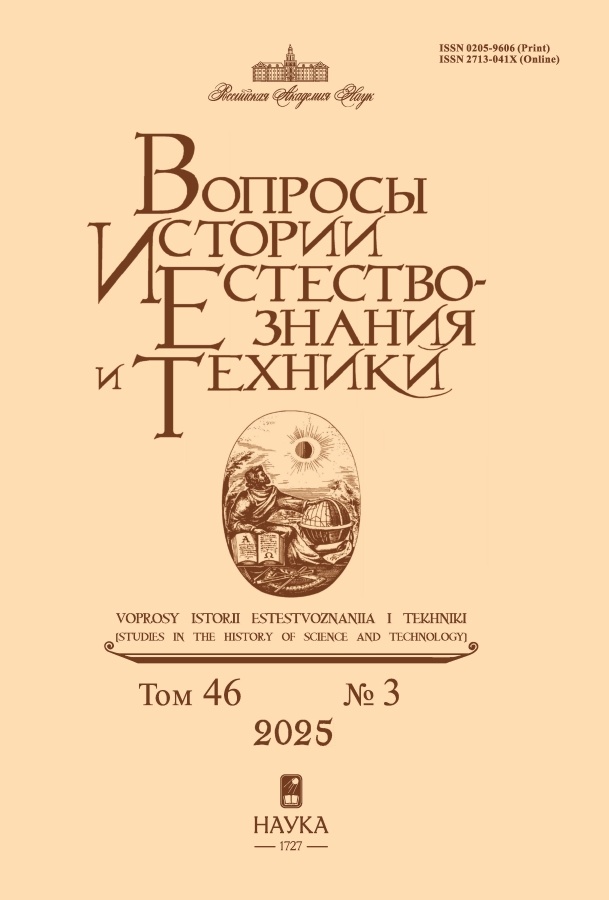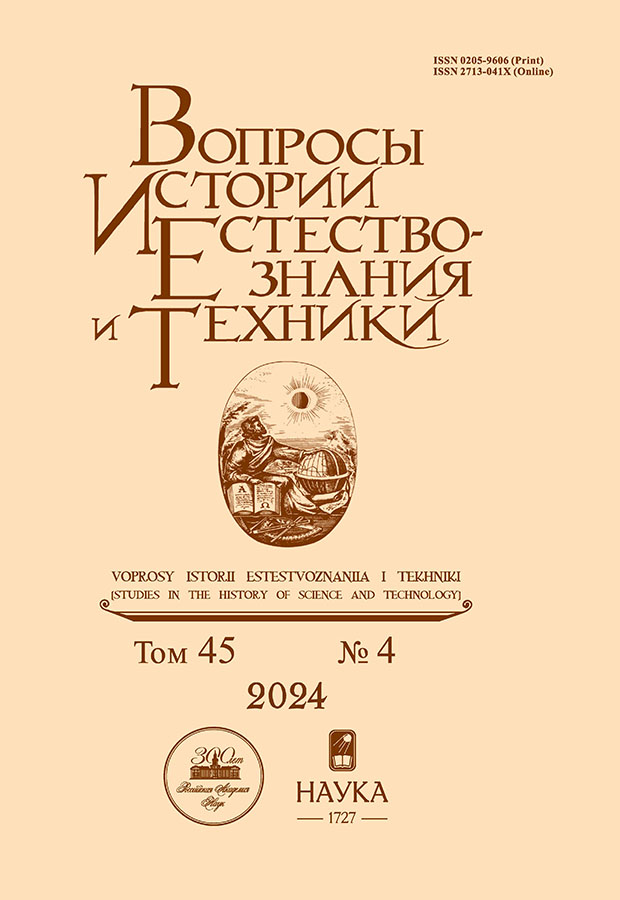Роль российского правительства и научных обществ в организации санитарно-профилактических мероприятий по борьбе с малярией в Туркестанском крае в конце XIX – начале XX в.
- Авторы: Закирова М.Х.1
-
Учреждения:
- Институт истории естествознания и техники им. С. И. Вавилова РАН
- Выпуск: Том 45, № 4 (2024)
- Страницы: 739-754
- Раздел: Социальная история науки
- URL: https://rjmseer.com/0205-9606/article/view/671150
- DOI: https://doi.org/10.31857/S0205960624040033
- EDN: https://elibrary.ru/WHKEDR
- ID: 671150
Цитировать
Полный текст
Аннотация
В конце XIX – начале XX в. в Туркестанском крае отмечалось усиление заболеваемости малярией, что влияло на повседневную жизнь и здоровье людей. В этой связи перед российскими властями и научным сообществом встала задача борьбы с распространением малярии в упомянутом регионе. В данной статье на основе анализа архивных документов Российского государственного военно-исторического архива, статей, опубликованных в газете «Туркестанские ведомости», и публикаций исследователей и медиков были рассмотрены основные причины появления малярии и методы борьбы с этим заболеванием в Центрально-Азиатском регионе. Показано, что распространение малярии было связано как с естественными (в числе которых следует отметить ежегодные разливы рек, заболачивание местности), так и с искусственными причинами (развитие ирригационной системы и расширение площадей, отведенных под рисоводство). Рассмотрена история открытия возбудителя и переносчиков малярии (комары рода Anopheles) и методов, применявшихся в Туркестанском крае для борьбы с ними (выработка определенного режима обводнения рисовых полей, использование некоторых видов рыб для борьбы с личинками комаров, применение с этой же целью ядохимикатов и продуктов нефтепереработки и др.).
Об авторах
Маргарита Хайдаровна Закирова
Институт истории естествознания и техники им. С. И. Вавилова РАН
Автор, ответственный за переписку.
Email: zakirova2023@outlook.com
Россия, 125315, Москва, ул. Балтийская, д. 14
Список литературы
- Alieva, R. R. (2016) Integratsiia – vazhnyi faktor na puti ustoichivogo sotsialʼno-ekonomicheskogo razvitiia gosudarstv Tsentralʼnoi Azii [Integration is an Important Factor on the Path of Sustainable Socio-Economic Development of Central Asian States], Tadzhikistan i sovremennyi mir, no. 1 (1), pp. 25–37.
- Artamonov, A. N. (1925) Maliariia v Samarkandskoi oblasti [Malaria in Samarkand Oblast], in: Grekova, A. D., and Dembo, G. I. (eds.) Maliariia v Srednei Azii [Malaria in Soviet Central Asia]. Tashkent: Narkomzdrav Uzbekistana, pp. 30–31.
- Favr, V. V. (1903) Opyt izucheniia maliarii v Rossii v sanitarnom otnoshenii [An Attempt at Studying Malaria in Russia from a Sanitary Perspective]. Kharʼkov: Tovarishchetvo “Pechatnia S. P. Iakovleva”.
- Gabrichevskii, G. N. (1904) Doklad Komissii po izucheniiu maliarii v Rossii [Report of the Commission for the Study of Malaria in Russia], in: Doklady Pravleniia obshchestva russkikh vrachei v pamiatʼ N. I. Pirogova i sostoiashchikh pri nem komissii IX Vserossiiskomu s”ezdu vrachei [Reports of the Board of the Society of Russian Physicians, Devoted to the Memory of N. I. Pirogov, and Its Commissions to the 9th All-Russian Congress of Physicians]. Moskva: Tovarishchetvo “Pechatnia S. P. Iakovleva”, pp. 1–13.
- Geier, I. I. (1894) Ot Tashkenta do Gavy [From Tashkent to Gava], Turkestanskie vedomosti, November 10, no. 81.
- Geier, I. I. (1895) Ot Tashkenta do Gavy [From Tashkent to Gava]. Tashkent: Tipo-litografiia br. Portsevykh.
- Ismailova, E., and Papava, V. (2010) Tsentralʼnaia Evraziia: geopoliticheskoe pereosmyslenie [Central Eurasia: Geopolitical Rethinking]. Stokgolʼm: CA & CC Press.
- Kassirskii, I. A. (1938) Ronalʼd Ross i maliariinaia problema: k 80-letiiu so dnia rozhdeniia R. Rossa [Ronald Ross and the Malaria Problem: Towards the 80th Anniversary of the Birth of R. Ross]. Moskva and Leningrad: Biomedgiz.
- Kolosov, G. (1901) Otchet po issledovaniiu zabolevaemosti maliariei v Ak-Dzharskoi, Sharapkhanskoi i Dzhetysuiskoi volostiakh Tashkentskogo uezda [Report on the Study of Malaria Incidence in Ak-Dzhar, Sharapkhan, and Dzhetysu Volosts of Tashkent Uyezd], in: Sbornik materialov dlia statistiki Syrdarʼinskoi oblasti [Collected Materials for Statistics of Syrdarya Province]. Tashkent: Syr-Darʼinskii oblastnoi statisticheskii komitet, vol. 9, pp. 1–60.
- Makhmudov, M. (1992) Stanovlenie i razvitie meditsiny i zdravookhraneniia v Srednei Azii (1867–1924 gg.): dis. ... d-ra ist. nauk [The Formation and Development of Medicine and Health Care in Central Asia (1867–1924). Thesis for the Doctor of Historical Sciences Degree]. Tashkent.
- Mark, S. A. (1902) Iz nabliudenii nad maliariei v Turkestane [From Observations on Malaria in Turkestan]. Sankt-Peterburg: Tipografiia Ia. Trei.
- Melik-Sarkisian, S. A. (1899) Urochishche Bus Ferganskoi oblasti. K voprosu o polozhenii khlopkovogo dela v Ferganskoi oblasti i mery k ego uporiadocheniiu [The area of Bus in Fergana Province. On the Situation in Cotton Industry in Fergana Province and Measures to Regulate It]. Sankt-Peterburg: Tipografiia M. D. Rudometova.
- Melik-Sarkisian, S. A. (1905) Kulʼtura risa v Ferganskoi oblasti i vliianie ee na zabolevaemostʼ maliariei [Rice Cultivation in Fergana Province and Its Influence on Malaria Incidence], in: O kulʼture risa v Turkestane i vliianii ee na zabolevaemostʼ maliariei [On Rice Cultivation in Turkestan and Its Influence on Malaria Incidence]. Tashkent: Tipo-litografiia V. M. Ilʼina, pp. 153–218.
- Mrangovius, V. Iu. (1901) Otchet po issledovaniiu zabolevaemosti maliariei v Toi-Tiubinskoi felʼdsherskoi territorii Tashkentskogo uezda [Report on the Study of Malaria Incidence in the Toi-Tyubinsk Feldscher Territory of Tashkent Uyezd], in: Sbornik materialov dlia statistiki Syr-Darʼinskoi oblasti [Collected Materials for Statistics of the Syrdarya Province]. Tashkent: Syr-Darʼinskii oblastnoi statisticheskii komitet, vol. 9, pp. 61–129.
- Nalivkin, V. P., and Nalivkina, M. V. (1886) Ocherk byta zhenshchin osedlogo tuzemnogo naseleniia Fergany [A Sketch of Everyday Life of Women of the Settled Native Population of Fergana]. Kazanʼ: Tipografiia universiteta.
- Narodnoe bedstvie v Tashkentskom uezde [National Disaster in Tashkent Uyezd] (1902), Turkestanskie vedomosti, February 10, no. 12, pp. 67–68.
- Pozniakov, V. P. (1905) Zapiska o kulʼture risa i ego znachenie v Samarkandskoi oblasti [A Memorandum on Rice Cultivation and Its Role in Samarkand Region], in: O kulʼture risa v Turkestane i vliianii ee na zabolevaemostʼ maliariei [On Rice Cultivation in Turkestan and Its Influence on Malaria Incidence]. Tashkent: Tipo-litografiia V. M. Ilʼina, pp. 47–152.
- Proekt mer borʼby s maliariei pri kolonizatsii maliariinykh mestnostei (1904) [Project of malaria control measures in the colonization of malarial areas], in: Doklady Pravleniia obshchestva russkikh vrachei v pamiatʼ N. I. Pirogova i sostoiashchikh pri nem komissii IX Vserossiiskomu s”ezdu vrachei [Reports of the Board of the Society of Russian Physicians, Devoted to the Memory of N. I. Pirogov, and Its Commissions to the 9th All-Russian Congress of Physicians]. Moskva: Tovarishchetvo “Pechatnia S. P. Iakovleva”, pp. 4–15.
- Rapchevskii, I. F. (1902) Nastavlenie o prichinakh maliariinykh zabolevanii i o meropriiatiiakh protiv nikh [Instruction on the Causes of Malarial Diseases and Measures against Them]. Sankt-Peterburg: Glavnoe voenno-meditsinskoe upravlenie.
- Shishov, A. (1904) Kolonizatsiia v maliariinykh mestakh (prodolzhenie) [Colonization in Malarial Areas (Continued)], Turkestanskie vedomosti, June 8, no. 77, p. 354.
- Shishov, A. (1904) Kolonizatsiia v maliariinykh mestakh [Colonization in Malarial Areas], Turkestanskie vedomosti, May 12, no. 64, p. 292.
- Shkapskii, O. A. (1905) O kulʼture risa v Syrdarʼinskoi oblasti v sviazi s razvitiem maliarii [On Rice Cultivation in Syrdarya Region in Connection with the Development of Malaria], in: O kulʼture risa v Turkestane i vliianii ee na zabolevaemostʼ maliariei [On Rice Cultivation in Turkestan and Its Influence on Malaria Incidence]. Tashkent: Tipo-litografiia V. M. Ilʼina, pp. 1–45.
- Vasilʼev, I. V. (1911) Maliariinye komary Turkestanskogo kraia v sviazi s kulʼturoi risa i opyty borʼby s nimi [Malarial Mosquitoes of Turkestan Krai in Connection with Rice Cultivation and the Attempts to Control Them], in: Trudy Biuro po entomologii Uchenogo komiteta Glavnogo upravleniia zemleustroistva i zemledeliia, izdavaemye pod redaktsiei zaveduiushchego biuro [Proceedings of the Bureau of Entomology of the Scientific Committee of the Principal Department of Land Management and Agriculture, Published under the Editorship of the Head of the Bureau]. Sankt-Peterburg: Tipografiia M. Merkusheva, vol. 9, no. 2, pp. 1–28.
- Vasilʼev, I. V. (1912) Vtoroe soobshchenie o maliariinykh komarakh Turkestanskogo kraia v sviazi s kulʼturoi risa i opytakh borʼby s nimi [Second Report on Malarial Mosquitoes of Turkestan Krai in Connection with Rice Cultivation and the Attempts to Control Them], in: Trudy Biuro po entomologii Uchenogo komiteta Glavnogo upravleniia zemleustroistva i zemledeliia, izdavaemye pod redaktsiei zaveduiushchego Biuro [Proceedings of the Bureau of Entomology of the Scientific Committee of the Principal Department of Land Management and Agriculture, Published under the Editorship of the Head of the Bureau]. Sankt-Peterburg: Tipografiia M. Merkusheva, vol. 9, no. 7, pp. 1–26.
- Voeikov, A. I. (1909) Chelovek i voda: sposoby polʼzovaniia vodoi i ikh geograficheskoe raspredelenie [Man and Water: Ways of Water Use and Their Geographical Distribution]. Sankt-Peterburg: Tipografiia M. M. Stasiulevicha.
Дополнительные файлы











